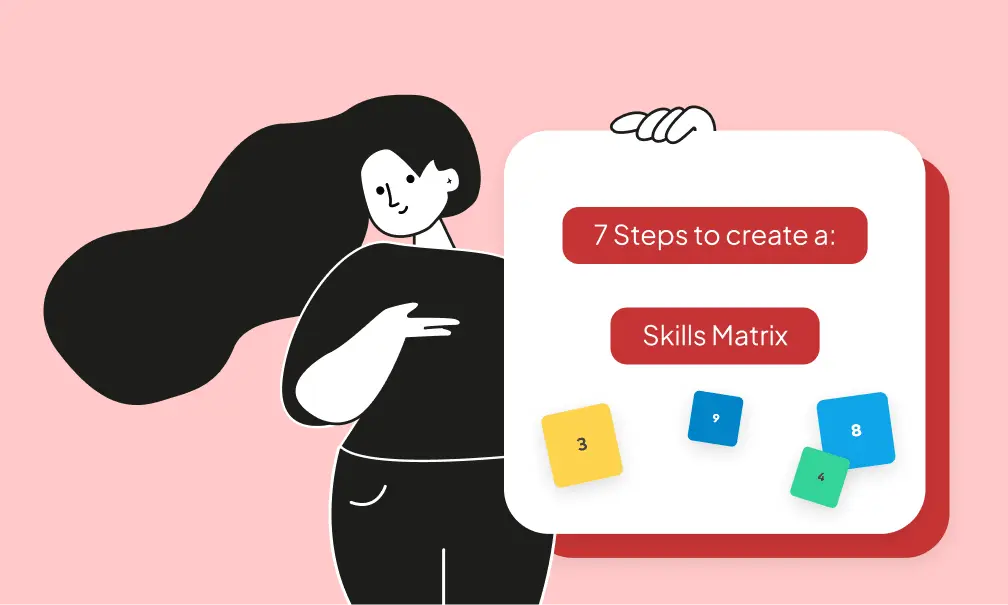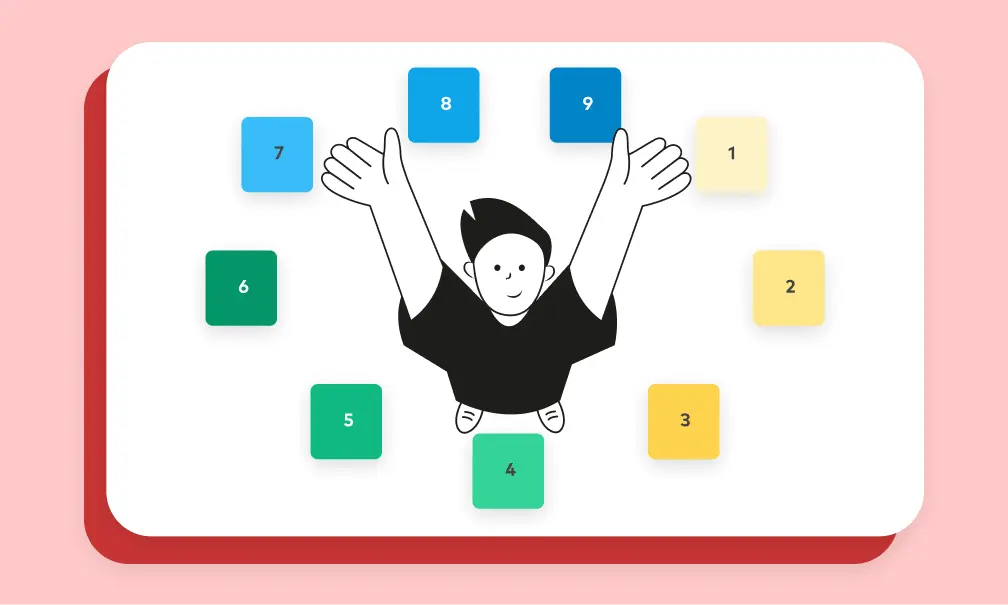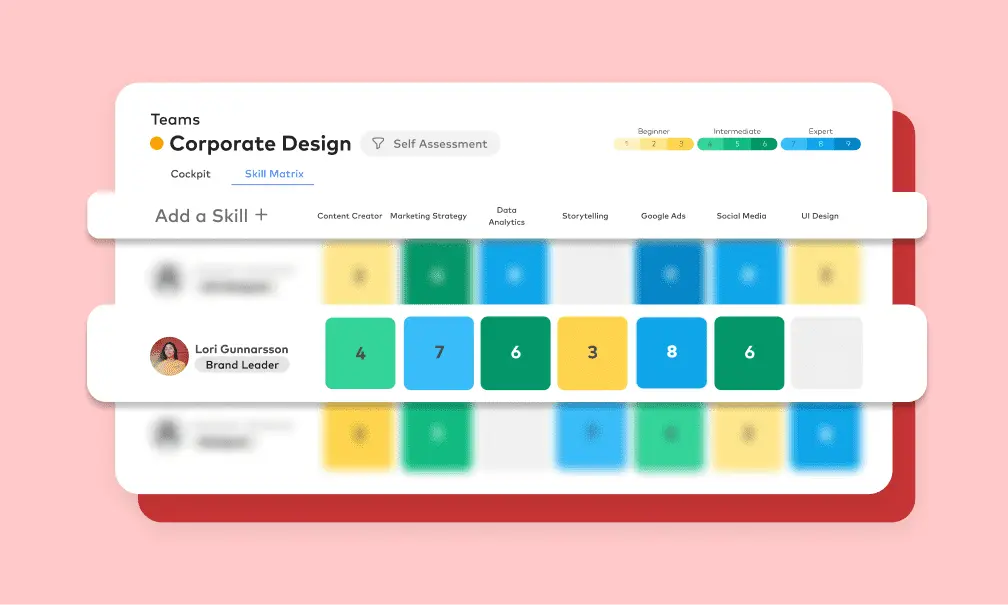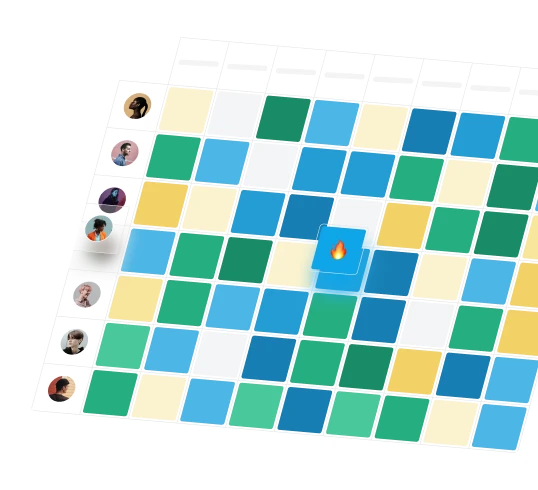
How To Create a Skills Matrix: A Comprehensive Guide


- Understanding The Structure of a Skills Matrix
- How To Create a Skills Matrix
- How can a Skills Matrix Software Help You?
- What To Avoid When Creating a Skills Matrix
- What now?
As a leader, you must be familiar with how a skills matrix helps keep track of your employees’ skills and competencies. But do you know how to create a skills matrix?
Your organization’s success is primarily built on how your employees perform and their skills.
Knowing how to make a skills matrix is a key differentiator, highlighting you amongst your competitors.
A skills matrix is a visual and analytical tool that allows organizations to map their employees’ skills and competencies.
This platform helps build a more resilient workforce and environment for your company, resulting in heightened productivity and profitability.
We suggest you read “What is a Skills Matrix?” to gain more information on how this robust tool constructs such benefits.
By knowing how to build a skills matrix, you can craft a well-designed interface that can efficiently identify skill gaps, help you make informed decisions about recruitment, allocate development programs, and more.
In this article, we will explore how to create a skills matrix, why you should build a skills matrix, and what to avoid when creating this platform to optimize your workforce’s capabilities besides raising organizational success.
Our skill matrix software allows you to enhance self-organization and efficiency.
Understanding The Structure of a Skills Matrix
Before diving into creating your own skills matrix, it is essential that you know what it entails.
A simple skills matrix is basically a grid or a table containing two axes: horizontal and vertical.
One axis includes the names of the employees, while the other enlists different key skills and competencies required for a particular role or project.
The intersection of the two axes represents the proficiency level of each employee in a specific skill.
How To Create a Skills Matrix

Creating a skills matrix bears much importance since it is a tool for determining your organization’s skill sets and future hires.
With a carefully created skills matrix and the correct approach to exploit it, you will unlock new possibilities for your company as well as your employees.
We have enlisted 7 straightforward steps for you to create a skills matrix:
1. Define the Purpose and Scope.
One critical step before creating the skills matrix itself is defining what the matrix is supposed to achieve.
Depending on your project, the current status of the organization, or future targets, you must consider the specific skills and competencies you need to assess, who will be involved in the process, and how the data will be exploited.
Having a clear purpose in mind enables you to focus on more essential areas and better identify the requirements and development opportunities.
2. Build a Data Inventory: Identify The Key Skills and Competencies.
In our next step, you should discover which skills are most relevant to your organization and even industry.
Contrary to most beliefs prioritizing technical skills, the key competencies vary in range, from hard skills to soft ones, industry-specific knowledge, and various certifications.
You must take different approaches to uncover all your organization’s requirements.
You can consult managers, team leaders, and HR professionals to ensure you have captured a comprehensive list of skill sets.
💡Pro Tip: What do your employees value?
Ask the most experienced employee in each business unit. It is common to miss trivial yet crucial factors impacting the employee experience.
Inquiring the employees and department heads is a practical way to cover all the bases.
There are several services, such as agyleOS, that ease the process of data inventory.
We provide you with accessible and straightforward tools such as skill matrix tool for further steps.
3. Choose a Grading System.
A grading system is used to evaluate and quantify proficiency levels.
You can choose conventional grading systems or generate your own approach to match your organization’s requirements.
There are some basic grading systems, such as:
- Likert Scale - This grading approach is not commonly used to collect skills matrix data. However, it is the most widely used approach to evaluate responses in research surveys.
- Number Scaling (10-point scale, 5-point scale, 9-point scale, etc.)
Regardless of your grading system, you must assign a definition to each variable. For example, in scaling systems, the variable is a number.
Suppose you choose a 9-point grading system; in that case, the definition of each number is similar to below:
1= The least experienced.
2= Somewhat trained yet inadequate experience.
3= Performing under particular circumstances.
4= Satisfying performance in most circumstances.
5= Actively and sufficiently performing.
6= Experience and performance are above average.
7= Performing under no supervision.
8= Experienced enough to lead a small team.
9= The most experienced and can train others.
Carefully crafted grading systems meet the requirements of larger companies and challenging environments since they are detailed and thorough.

⭐How does our 9-point grading system at agyleOS benefit your organization?
A 9-point grading system with a broad spectrum of ratings avoids confusion in decision-making.
Suppose you want to promote one employee out of 10 candidates.
In that case, a 5-point grading system will likely give you over five candidates with a rating of 2 to 3.
In this scenario, a 9-point grading system divides those candidates by rating them between 4 and 8, making your decision simpler and much more effective.
-
Evaluate Each Employee.
After advancing a grading system, it is time to use it. In this step, you will embark on your journey to discover each employee’s proficiency levels in various fields.
For an extensive and adequate database, you must conquer all the approaches to employee evaluation.
A few viable assessments are:
-
Self-assessment:
Ask your employee to rate and give themself a performance review. This MO outlines the strength of each employee according to their own experience at your organization.
💡Pro Tip: Ask About Your Employee’s Interests!
A typical skills matrix is a tool identifying the current and missing talents. However, it is also an approach to demonstrating the potential skills.
By asking your employees about their professional interests, and personal improvable traits, you have enough data for a skills matrix so it can display what development programs and training are necessary for your organization.
-
Explore the documents:
Examine the past performance reviews and records to analyze how an employee has thrived and what skills they have developed over time.
-
Ask For Manager Evaluation:
With this method, you can assess the relationship between the employees and their leaders.
You can also conclude how a leader evaluates its workforce.
-
Ask For a Team Member Evaluation:
This approach allows you to comprehend an employee’s soft skills.
Teamwork capacity, work attitude, and behavioral patterns are all accessible through a colleague’s point of view.
-
Run a Test:
Look for the necessary hard or soft skills with a quick test and assess an employee’s proficiency level.
A customized test lets you prioritize the targets and purposes for which you are creating a skills matrix.
-
360-Degree Feedback Tool:
Here is the most viable and thorough approach you can take:
Designed with real-time assessments and dynamic skill monitoring, a 360-degree feedback tool is the best strategy for evaluating an employee.
If you’re wondering how to create a skills matrix, this strategic survey-like method results in a detailed and practical database.
What makes our 360-degree feedback tool comprehensive is the constructive elements:
self-assessment, colleagues’ reviews, and anonymous comments from peers, filtering items to choose specific skills and employees, constant updating status of employees regarding their position in different teams and projects, and insightful radar charts are a few of our numerous options when conducting the 360-degree sessions in combination with our powerful skill management system.
In each 360-degree feedback session, the employee is getting assessed by their manager, team leader, subordinates, peers, etc.
Moreover, a more thorough session includes inquiring about employees’ experiences and interests for better comprehension of the workforce.
We help you run efficient and thorough 360-degree feedback sessions to prepare your people for your next challenges ahead!
Needless to exploit all the approaches to evaluating the employees, choose a few, or combine them to create a well-designed method to assess your company’s status.
The fastest combo to employee evaluation is a self-assessment and a certificate check:
Letting your employees express genuine sentiments about their skills, besides a quick quality check, is your way to go for the fastest results.
The most essential part of this step is to have a thorough understanding of everyone’s skills and proficiency levels.
5. How To Build a Skills Matrix Table:
As mentioned before, a skills matrix can be a basic table or grid: you can design your traditional matrix using an Excel spreadsheet.
However, there is a catch. Since each organization has a different status and requirement, you must design a skills matrix that matches your company’s best interest.
A typical skills matrix must include the employees’ names, required skills, proficiency levels, and other company-related items that fulfill your organization’s purposes.
Here is an example of a skills matrix grid:

Note that designing the matrix is one of the most significant steps, and the crafted matrix must have a user-friendly interface and an easy-to-use guide.
6. Fill In The Fields!
Once you have created your matrix, it is time to populate it. Use the data you gathered in step 4 and fill each blank with the correct information.
A simple approach is assigning the vertical axis to employees’ names and the horizontal one to different skills.
The corresponding blocks should contain the proficiency level of each employee in a specific skill.
This step can be done manually or via skills matrix softwares.
Make sure to update your matrix regularly to keep track of the employee skill levels over time.
7. Analyze The Data and Start Planning
All the work comes to this step!
After having created and filled the skills matrix, you should start analyzing the data according to your status.
Whether taking on a new project with particular requirements, doing an HR analysis, or considering new hires, data analysis will help you through the process.
Once you comprehend the data, you can visualize your organization’s requirements and potential.
Deploying the skills matrix analysis outcomes, you will consider strategic approaches and training programs for individuals in your company so they can grow and learn to create a resilient workplace.
A skills matrix empowers individuals and companies to live up to their potential and enhance productivity and profitability.
⭐Pro Tip: How should you define competencies and plan for development programs?
Align to the expectations! An ideal team consists of competent leaders and team members, whereas a realistic team always has flaws.
By comparing our team to an ideal one (obviously for the same project!), we can reach an agreeable difference in proficiency levels.
Remember that our goal here is not to push people but to encourage them to grow and contribute to designed training programs for a better work experience and overall organizational success.
How can a Skills Matrix Software Help You?

You may successfully create your desired table with the help of our step-by-step guide on how to build a skills matrix.
However, your matrix, no matter how detailed, is traditional. Traditional matrices come with a few complications:
-
Chaos:
It’s not a matter of organizing or tidiness!
A traditional skills matrix, especially for larger companies, tends to become complicated and messy, drowning you in information.
-
Time-Consuming:
Suppose you need to make a quick decision about an employee, or you need to report an overall report on your organization or just a simple skill check.
In that case, a traditional skills matrix is quite complex to read. Finding specific data amongst a sea of information and numbers will take considerable time and is inefficient.
However, a skills matrix software is designed to provide organized and easy-to-use data with visual and comprehensive charts and graphs.
This software allows you to gather, allocate, and analyze the necessary information for a skills matrix, making your job easier and more efficient over time.
At agyleOS, we help you discover your company’s hidden potential.
Besides, we guide you in planning further development programs to outperform your competitors in every possible field.
What To Avoid When Creating a Skills Matrix

After learning how to make a skills matrix, you must comprehend what pitfalls to avoid in order to successfully exploit your outcomes.
If created properly, a skills matrix is a powerful tool for organizational success.
Here, we have examined a few don’ts when creating a skills matrix:
1. Poor alignment of the workforce’s skills to the company’s goals:
You must identify your organization's goals and purposes before assessing your employees’ proficiency levels in different areas.
If you fail to state your business goals clearly, a skills matrix will have a limited impact!
2. Forgetting to update the skills matrix regularly!
One primary principle in creating a skill matrix is updating it to keep track of your employees’ progress and the efficiency of the development programs.
Returning to your organization's previous status is inevitable by ignoring the update of the skills matrix.
3. Overpopulating the skills matrix: chaos!
This pitfall concerns larger organizations more particularly. If you have many employees, it’s only expected if you need to add columns and rows to your spreadsheet.
However, you must know that overcomplicated and overpopulated matrices are no one’s friend!
Not only can they not help you, but they will also create frustration and confusion in decision-making.
One simple and inexpensive solution to this problem is using a skill matrix software.
Our skill matrix tool at agyleOS helps you gather, organize, and analyze competency-related information through various approaches, such as our employee performance reviews tool, for a holistic view of your organization.
4. Failing to assess the right skills:
Knowing what skills to assess is the first and one of the most important steps in creating a skills matrix.
The skills matrix will probably not benefit your organization if you fail to choose the right skills for evaluation.
Suppose you need to review a group of employees for a web development job and another for networking positions.
Obviously, positive behavior is a more important trait than knowing JavaScript in the latter group!
5. Not taking the last step!!!
What value does your matrix offer if you fail to deploy it properly?
It might sound silly, but many decide against taking proactive steps to design development programs since their employees’ assessments are “enough”.
However, after collecting your data, the most important job is planning your company’s next moves for training programs.
By integrating other HR systems, such as eNPS surveys, employee reviews, etc., you get a chance to plan strategic programs and development opportunities in your organization.
6. Overly prioritizing the job titles!
One common yet discrediting mistake when you intend to make a skills matrix is depending “too much” on the job titles.
A skills matrix is about each individual having the opportunity to expose their full potential and talents regardless of their current position.
Whether reviewing a manager’s performance or any other employee’s, you must unbiasedly grade their skills and competencies in various fields.
This important factor constitutes the skills matrix as a beneficial platform for future recruitment and promotions.
7. Not communicating the outcomes:
Once the skills matrix is complete, it is only fair that you share the results and data with your workforce.
Suppose you want an employee to have a more positive work attitude, develop a new technical skill, or exercise new knowledge.
In that case, you must exchange feedback with them to reach an agreement and plan for your individual and organizational success.
What now?
Learn how to create a skills matrix with our detailed step-by-step guide to promote knowledge, skills learning, and passion in your organization.
Knowing how to build a skills matrix may seem like a straightforward task, and it is!
However, you must watch out for the pitfalls on the way to avoid and complete each step as demonstrated.
By deploying the right tips and equipment, you can create a skills matrix to analyze and empower your organization as a whole.
Nevertheless, if you fail to prioritize the right skills, discriminate against your employees due to job titles, overpopulate a simple matrix, or fall short of action against the issues. In that case, the skills matrix will help you much.
Moreover, suppose you need a more detailed chart, or you have too many employees for a traditional matrix.
In that case, consider using a skill matrix software to gather data, build up specific charts, and filter employees based on various skills, etc.
A skill matrix software helps you run a smooth operation with a more positive workplace and higher productivity.
By submitting this form, I confirm that I have read the privacy policy and that I consent to the processing of my personal data by agyleOS for the purposes stated. In the event of consent, I can revoke my consent at any time. Furthermore, by submitting the form, I agree to the general terms and conditions.


- Product
- Resources
- Compare
- Company
